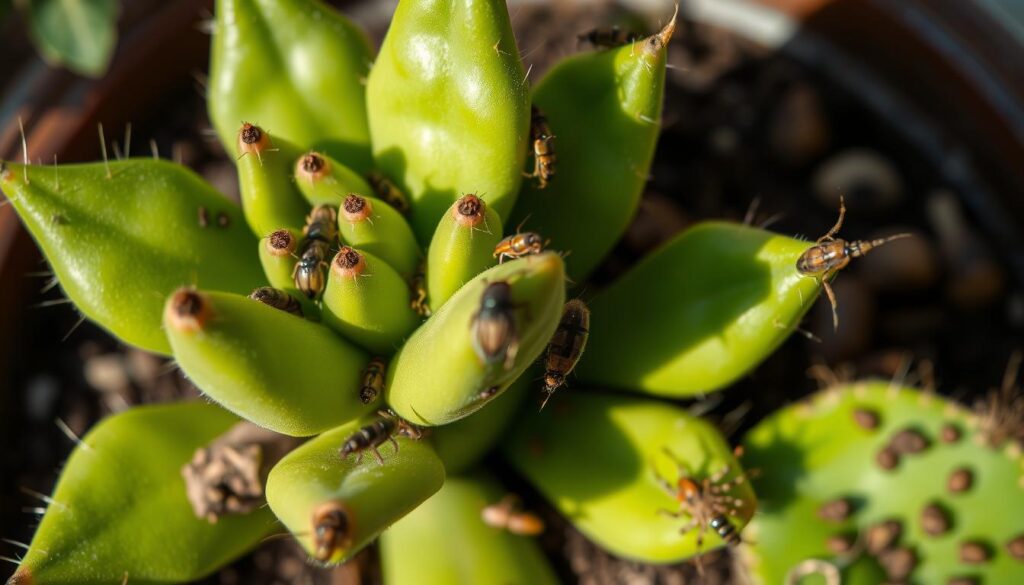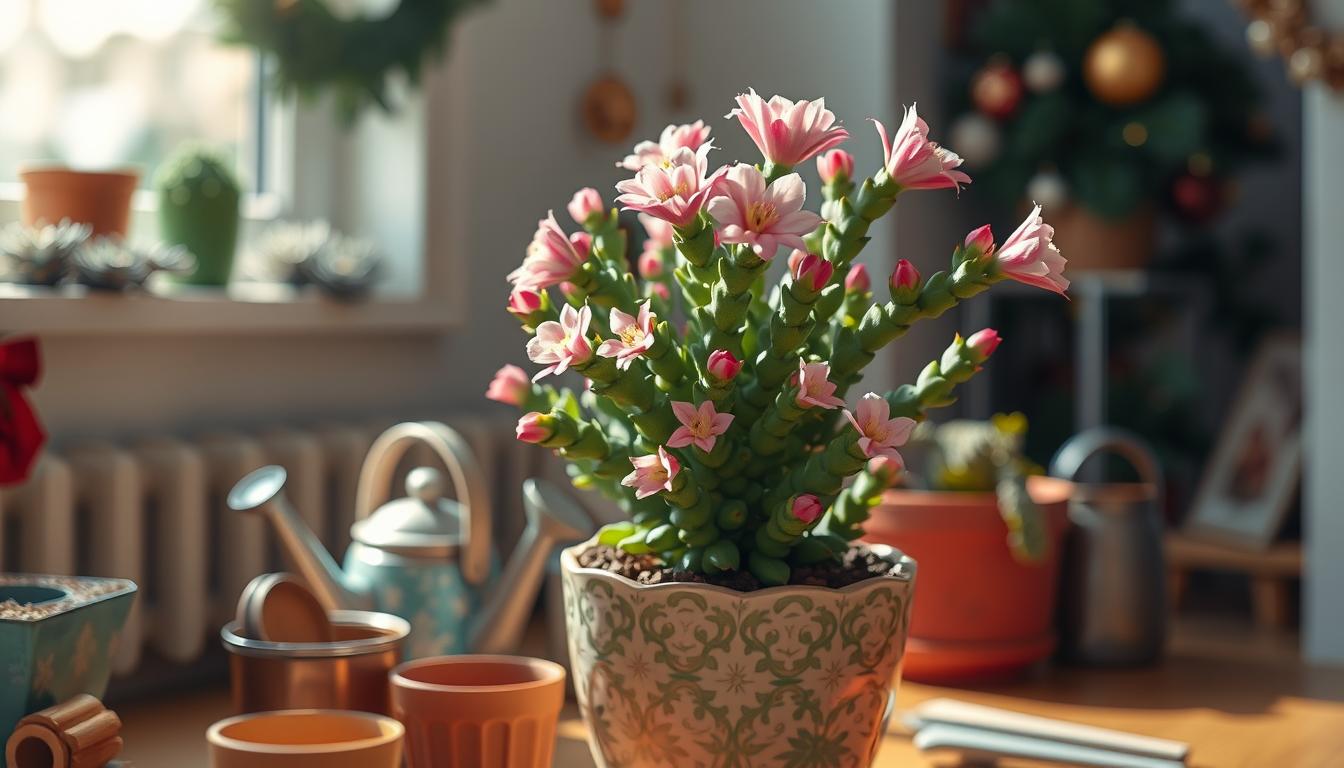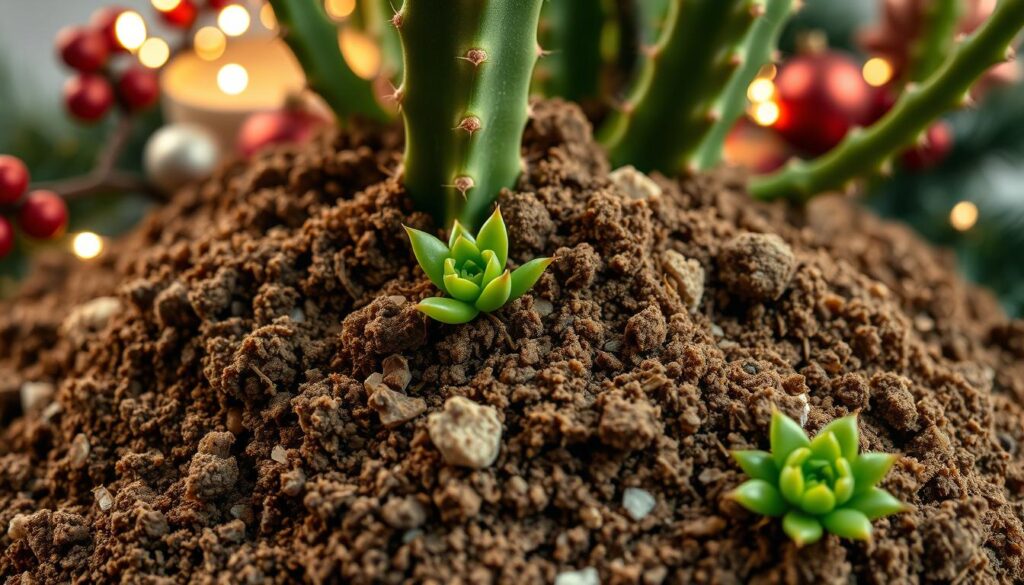Succulents and cacti are not just for the desert. They can also grow well indoors. They add beauty and color to your home with little work. Learning how to care for Christmas Cactus is key to keeping it healthy and beautiful.
Christmas Cactus is a favorite holiday plant. It blooms in many colors like red, pink, and white. With the right care, it can brighten your home all winter.
Knowing what your Christmas Cactus needs is important. It requires the right light, water, and care. By learning about Christmas Cactus care, you’ll become a great caretaker. You’ll also enjoy the many benefits it brings to your home.
Understanding the Christmas Cactus: A Unique Holiday Plant
Exploring the Christmas Cactus reveals its deep Christmas Cactus history and why it’s a favorite holiday plant. It comes from Brazil’s rainforests. It loves humid, cool places. Its winter blooms make it special in homes.
The Christmas Cactus blooms with red, pink, white, or purple flowers. These flowers are about 3 inches long. They bloom for about two weeks. Each flower lasts a few days.
- Optimal temperature for growth ranges from 60 to 70 degrees Fahrenheit
- Ideal light exposure requires bright, indirect light for at least 10 hours per day
- Fertilization every two weeks during the active growth period is recommended
Knowing the Christmas Cactus history and its distinguishing characteristics helps. It lets you care for this holiday plant better.
| Characteristics | Description |
|---|---|
| Flower Color | Red, pink, white, or purple |
| Flower Length | Roughly 3 inches |
| Blooming Period | Typically lasts about two weeks |
Choosing the Right Environment for Your Christmas Cactus
To make your Christmas Cactus happy, think about the light and temperature in your home. 1-800-Flowers.com says bright, indirect light and cooler temps are key. East- or west-facing windows are great because they offer the right light without being too harsh.
Don’t put your Christmas Cactus in direct sunlight, especially in summer. It can make the leaves turn funny colors. Keep it in a spot that’s cooler, between 60-70°F. Also, stay away from heating vents and drafty windows to keep it stress-free.
Optimal Light Conditions
Light is very important for your Christmas Cactus. It needs 4-6 hours of bright, indirect light every day. Make sure it gets 8-10 hours of dark at night in fall and winter. This helps it bloom and grow well.
Give your Christmas Cactus the right home, with good light and temperature. This way, you can enjoy its flowers for a long time. With the right care, it can live up to 100 years, becoming a family tradition.
| Season | Lighting Requirements | Temperature Requirements |
|---|---|---|
| Fall and Winter | 4-6 hours of bright, indirect light | 60-70°F |
| Spring and Summer | 6-8 hours of bright, indirect light | 65-75°F |
Essential Watering Techniques for Christmas Cactus
Watering your Christmas Cactus right is key. Don’t overwater, as it can cause root rot. Water only when the top inch of soil feels dry. You can check this by sticking your finger into the soil up to the first knuckle.
Knowing the difference between overwatering and underwatering is important. Soft, mushy leaves mean you’re watering too much. Dry, wrinkled leaves mean you’re not watering enough. Adjust your watering techniques to keep your Christmas Cactus happy. For more tips, visit trusted resources.
- Water your Christmas Cactus when the top 1-2 inches of soil are dry
- Reduce watering in the fall to encourage blooming
- Use well-draining soil to prevent waterlogged soil
Optimal Soil and Potting for Your Christmas Cactus
Choosing the right soil and potting mix is key for your Christmas Cactus. A mix made for cacti and succulents is best. It prevents waterlogged soil and root rot. Goodhousekeeping.com says using such a mix is a good idea.
Best Soil Types for Succulents
It’s important to pick the right soil for your Christmas Cactus. A mix of regular potting soil and perlite or vermiculite is good. You can also use a mix with compost, perlite or vermiculite, and milled peat.
The soil should be slightly acidic, with a pH of 6.0 to 6.5. It also needs good drainage to avoid root rot. Repotting every 2-3 years helps with growth and nutrients.
When repotting, pick a pot that’s only a bit bigger. Add fresh potting soil and press it down. Make sure the soil covers the roots up to 1 inch below the pot’s rim. Use pots with drainage holes, like terracotta, to control moisture.
- Check for root binding and repot before flower buds begin to form.
- Use a pot that is 1 to 2 inches wider than the current pot.
- Add a layer of 2 to 3 inches of fresh potting soil.
By following these tips and using the right soil and potting mix, your Christmas Cactus will thrive.
| Soil Type | Drainage | pH Range |
|---|---|---|
| Regular Potting Soil | Poor | 6.0-7.0 |
| Cacti and Succulents Mix | Good | 6.0-6.5 |
| Compost, Perlite, and Milled Peat Mix | Excellent | 6.0-6.5 |
Fertilizing Your Christmas Cactus for Vibrant Blooms
To help your Christmas Cactus grow well and bloom brightly, fertilizing is key. 1-800-Flowers.com says to use a balanced, water-soluble fertilizer in spring and summer. Make sure to water it down to half the usual amount to keep the roots safe.
In the fall, use a fertilizer with more phosphorus to help it bloom. Fertilizers for flowering plants like cacti and succulents work great. Proper fertilizing will make your Christmas Cactus bloom more and stay healthy.
Here are some tips for Christmas Cactus fertilization:
- Use a balanced fertilizer (20-20-20) during the growing season
- Switch to a low-nitrogen fertilizer (0-15-0) in the fall to encourage blooming
- Dilute the fertilizer to half the recommended strength
- Apply fertilizer every 12 to 16 weeks during active growth
By following these tips and using the right flowering fertilizers, you can enjoy vibrant blooms from your Christmas Cactus. Remember to stop fertilizing during the resting period. Start again when you see new growth in late winter or early spring.
| Fertilizer Type | Application Frequency |
|---|---|
| Balanced Fertilizer (20-20-20) | Every 12 to 16 weeks during active growth |
| Low-Nitrogen Fertilizer (0-15-0) | In the fall to encourage blooming |
Managing Temperature and Humidity for Your Plant
To make your Christmas Cactus happy, you need to watch the temperature and humidity. The Christmas Cactus temperature should be between 60-70°F. It’s best to keep it cooler at night. Don’t put your plant near heaters or radiators because it can get stressed and not bloom.
Christmas Cacti like a humid place, with humidity around 50-60%. You can use a tray with water and pebbles or a humidifier. Keeping the right temperature and humidity helps your plant grow well.
Ideal Temperature Ranges
The best temperature for your Christmas Cactus is 60-70°F. It’s important to keep the temperature steady. A cooler temperature, around 50-55°F, in the fall helps it bloom.
Humidity Preferences and How to Maintain Them
Christmas Cacti like a humid place, with humidity around 50-60%. To keep it humid, you can use a tray with water and pebbles or a humidifier. This makes your plant happy and healthy.
| Temperature | Humidity |
|---|---|
| 60-70°F | 50-60% |
Pruning and Propagating Your Christmas Cactus
It’s key to know about pruning and propagating your Christmas Cactus. Goodhousekeeping.com says pruning after blooming helps the plant grow new. You need to cut off dead parts with sharp scissors or shears.
Pruning right after blooming makes your plant bushy. You can cut off up to a third of the plant each year. This keeps it the right size and encourages new growth. Cutting too much can shock the plant and slow its growth.
To propagate your Christmas Cactus, cut a segment from the plant. Let it dry for a few days. Then, plant it in soil that drains well. Cuttings should be 3-4 segments long. These steps help your plant stay healthy and grow well.
Here are some important tips for pruning and propagating your Christmas Cactus:
- Prune your plant after it has finished blooming to encourage new growth
- Remove up to a third of the plant each year to maintain its size and promote bushy growth
- Use clean, sharp scissors or pruning shears to remove dead or damaged segments
- Allow cuttings to dry for a few days before planting them in well-draining soil
By following these tips, you can have a healthy Christmas Cactus. It will bloom beautifully for many years.
Dealing with Pests and Diseases
When you care for your Christmas Cactus, watch out for pests and diseases. Check your plant often to catch problems early. This way, you can stop them from getting worse. 1-800-Flowers.com says it’s key to check your plant for pests or diseases.
Common pests like mealybugs, spider mites, and scale can harm your Christmas Cactus. They can make leaves turn yellow or grow wrong. They can also cause sooty mold. To keep pests away, water your plant every one to two weeks. Let the top inch of soil dry out before watering again. Neem oil can also help prevent pests and diseases.

Preventing pests and diseases is important. Good air flow and a well-draining potting mix can help. Being careful and taking steps ahead can keep your Christmas Cactus healthy. Here are some ways to prevent problems:
- Check your plant often for pests or diseases
- Water your Christmas Cactus every one to two weeks
- Use a well-draining potting mix
- Make sure air flows well around your plant
- Use neem oil regularly
By following these tips, you can keep pests and diseases away. This way, your Christmas Cactus will bloom beautifully for many years.
Embracing the Blooms: Enjoying Your Christmas Cactus Year After Year
As the vibrant Christmas Cactus blooms light up your home, it’s time to enjoy them. With the right care, your plant can bloom again in the spring. This means you can see its beautiful Christmas Cactus blooms for longer.
To make it bloom again, water it less and keep it cooler. ThePlantGuide.net says this helps it grow new flowers. Use your holiday decor to highlight the blooms, making them the star of your festive look.
By following these easy steps, you can enjoy your Christmas Cactus every year. It becomes a special holiday tradition in your home. Be proud of your green thumb and the happiness your plant brings.





